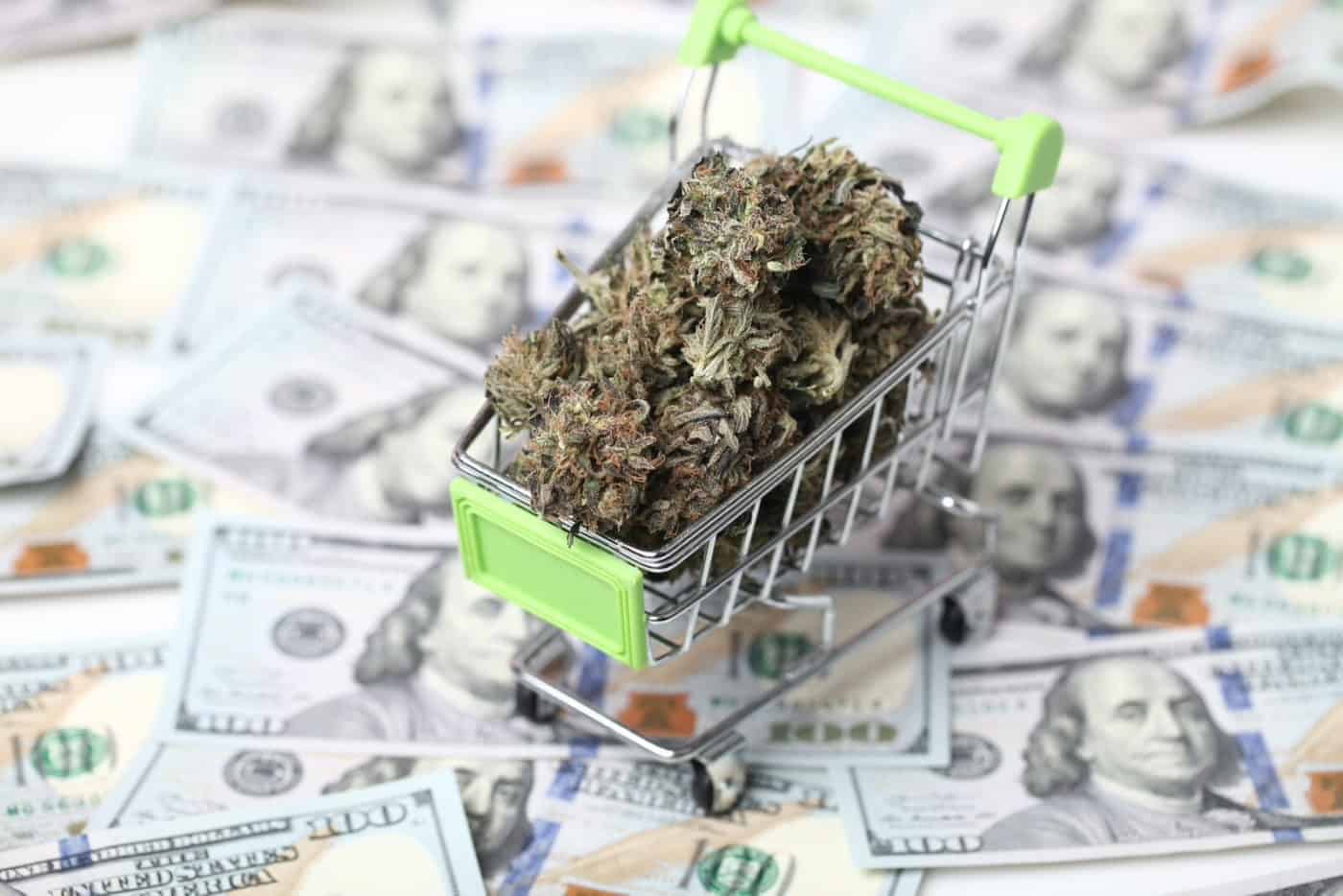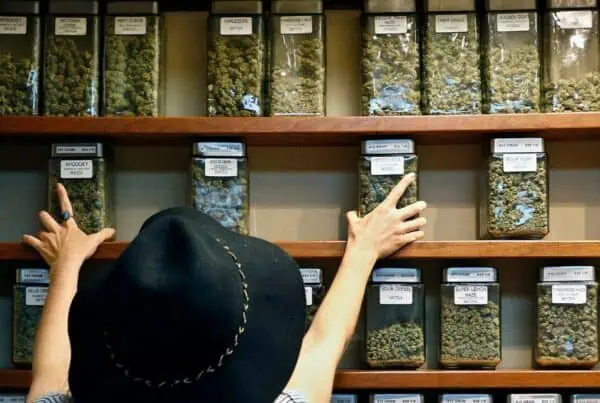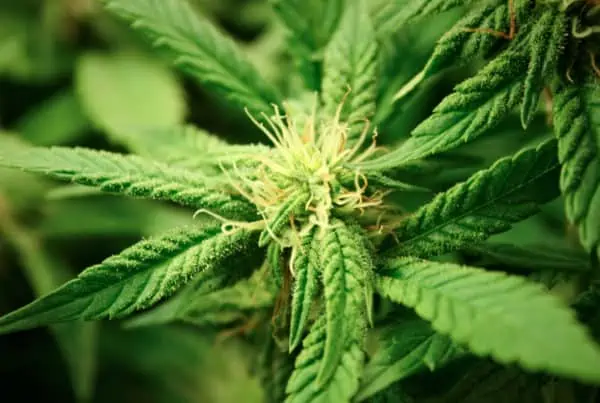TABLE OF CONTENTS
New Frontier Data expects global cannabis sales to reach $55 billion by 2025.
Despite the COVID-19 pandemic, its consequences on the global economy, and a lack of federal legalization, the cannabis industry is thriving.
Learning how to start a cannabis business requires a solid strategy to weather the challenges of the marijuana industry.
Starting a successful cannabis business is quite possible with the right guidance, planning, and financing. New marijuana business ventures need to consider everything, including the application process, startup costs, funding, and state regulations.

Learn About the Cannabis Industry Challenges
Starting a cannabis business requires understanding your licensing application process and the different laws, including state law and laws on the federal level, that shape the legal cannabis industry. These marijuana laws and consumer trends are constantly changing in the industry.
Whether you are new to the industry or are seasoned in the world of cannabis, a comprehensive cannabis education can prepare your marijuana business to compete with other businesses, some of which may be vertically integrated and have operations in multiple markets.
Cannabis Training University is the world's most renowned online industry training program, helping students grow their hobbies, careers, or businesses. Our complete online cannabis curriculum can guide you through the essentials of starting a cannabis business and covers the following topics and many more:
- Government regulations
- Cannabis industry challenges
- Creating a business plan
- Creating a pitch deck
- Marketing and advertising
- Transporting products
- Inventory management
- Insurance
- Legal considerations

13 Steps on How To Start A Cannabis Business
How to Get Started in the Marijuana Business
The legal cannabis market is projected to reach $65 billion by the year 2028, making it one of the businesses with the most rapid expansion rates in the world.
Here are 13 steps on how to start a cannabis business.
1. Become Knowledgeable About The Cannabis Industry In Your Area
As a result of the fact that the cannabis laws and regulations in each state are unique, it is essential to conduct research on the market in your state before beginning any endeavors related to cannabis.
This includes being aware of the prerequisites for obtaining a business license, the categories of cannabis-related enterprises that are permitted, and the taxes that will be levied against your company.
2. Create a Detailed Business Plan & Pitch Deck
Creating a cannabis business plan will assist you in defining the objectives, approaches, and financial predictions for your company.
Before beginning the process of looking for finance or investors, it is critical to have a business plan that has been carefully crafted and thoroughly considered.
If you want to start a cannabis business, you need a solid marijuana business plan to guide your operations and scale your business.
A business plan clearly outlines your business type (cultivation, testing, extraction, processing, retail, distribution, ancillary), which will affect your target market and operational practices.
Business plans can be used internally to guide the staff and owners or be used as a resource for potential investors.
A marijuana business plan should include market analysis, marketing and sales plan, research and development, facility operating plan, finances, and more to cover the planned growth of your marijuana business. You can download a cannabis business plan once a student in our Master of Cannabis certification program.
Starting a cannabis business requires a high upfront and ongoing investment. Traditional bank financing is hard to come by in this industry due to federal regulations. Obtaining funding from investors can help you cover the wide range of startup, development, and operational costs.
Startup costs can include non-refundable application fees, which can be several thousand dollars. Ongoing expenses can include annual licensing costs, which can reach six figures. Many states may also require showing proof of liquid funds of at least $1 million.
Business costs can include:
- Business license and application
- Tax/seller's permit
- Marketing
- Security
- Rent
- Utilities
- Equipment
- Employee wages
We provide a list of the best financial institutions that lend to cannabis businesses.
3. Decide on a Legal Framework For Your Cannabis Company
Your cannabis company will require you choose a legal structure for operation, such as a single proprietorship, partnership, limited liability company, or corporation.
Your unique requirements and objectives will determine the type of business structure that is most suitable for you.
4. Obtain Any Cannabis Licenses and Permits
After deciding on a business structure, the next step is to acquire the licenses and permits required to run your cannabis company legally. The particular procedures will be different depending on the state in which you reside, but it is quite likely that you will be required to obtain a business license, a cannabis license, and any other permissions that are relevant.
Before starting your marijuana business, research the legality of cannabis in your city, county, and state.
Is cannabis legal for medical and/or recreational use? Knowing the application deadlines and launch date of cannabis markets can help aspiring cannabis entrepreneurs start on the right foot.
Cannabis entrepreneurs should also look at the states that could legalize marijuana in 2024. Staying up-to-date with cannabis legalization news can inform business owners who want to start a business or expand in certain states.
Many marijuana entrepreneurs in the legal cannabis industry are betting big on hemp-derived cannabidiol (CBD) products due to their federally legal status.
Under federal law, hemp-derived CBD products containing less than 0.3% THC by dry weight are legal. While CBD may be legal, it may not be legal to ship to certain states, and certain CBD-derived products may be restricted.
5. Obtain the Necessary Cannabis Business Funding
Because it can be costly to launch a cannabis business, you will need to locate cash in order to get things rolling. This may come from personal savings, loans from investors, or funds raised through crowdfunding platforms.
Federal cannabis banking reform may help, but marijuana companies shouldn't stake their future on it. Banks are hesitant to provide financing for cannabis businesses since cannabis is an illegal product under federal law
Since most banks do not work with cannabis companies, marijuana entrepreneurs must find creative ways of finding funding for their cannabis company.
Cannabis businesses must get funding from outside investors, venture capitalists, private equity firms, and alternative financing institutions. Learn more about financing your cannabis business in our blog post.
Starting a cannabis business requires a high upfront and ongoing investment. Traditional bank financing is hard to come by in this industry due to federal regulations. Obtaining funding from investors can help you cover the wide range of startup, development, and operational costs.
Startup costs can include non-refundable application fees, which can be several thousand dollars. Ongoing expenses can include annual licensing costs, which can reach six figures. Many states may also require showing proof of liquid funds of at least $1 million.
Business costs can include:
- Business license and application
- Tax/seller's permit
- Marketing
- Security
- Rent
- Utilities
- Equipment
- Employee wages
We provide a list of the best financial institutions that lend to cannabis businesses.
6. Identify a Suitable Location For your Cannabis Business
After you have secured the necessary money, the next step is to look for a suitable location for your cannabis business. It is necessary that the location fulfill all of the zoning rules imposed by both the state and the municipality.
7. Recruit and Hire Some Amazing Employees
If you intend to have workers for your firm, you will need to recruit personnel and instruct them in the policies and procedures of both your company and the cannabis market.
For long-term success, cannabis entrepreneurs must create a team of experienced workers with the right talent.
Business employees can range from dispensary budtenders to an experienced attorney that can provide you with legal counsel on the latest cannabis industry laws.
When hiring employees for your company, direct cannabis experience should not be a requirement. Since the cannabis space is a relatively new industry, you may need to hire someone outside of the industry who has the right transferable skills.
8. Get The Word Out About Your Company
After getting your cannabis business up and running, you will need to promote it to those who might be interested in purchasing some of its products. This could include marketing done on the internet, marketing done on social media, and even advertising done in print.
Cannabis advertising laws are notoriously strict to reduce exposure to young people. We recommend researching your state and local advertising regulations for cannabis before launching a cannabis marketing strategy.
You must also stay up-to-date with the latest advertising laws to ensure your packaging and advertising are state-compliant.
When advertising on social media, you will have to follow each platform's policy on cannabis or illegal substances. If not, a post or an entire account can be suspended for violating terms of service, resulting in losing your followers and business profile.
9. Comply With All Federal and State Cannabis Laws & Regulations
It is essential to ensure that your cannabis company is in full compliance with any and all legislation that may apply to it. This covers things like tracking from the seed to the sale, standards for security, and criteria for product testing.
10. Target a Specific Segment Of The Cannabis Market
Because of the high level of competition in the cannabis sector, it is essential to zero in on a certain market segment. This could refer to a particular category of cannabis product, a distinct group of customers, or a particular region of the country.
In the cannabis industry, there are many different plant-touching segments, including cannabis cultivation, extraction, retail, and ancillary businesses that provide essential services such as accounting, insurance, security, real estate, and marketing.
Ancillary businesses do not have to worry about the red tape that plant-touching marijuana businesses face.
In some states, vertical integration is allowed or required, which means that a marijuana business must grow, process, and deliver the cannabis they sell.
In other states, vertical integration is not required, and operators can apply to get a particular cannabis license. Choose your cannabis business type wisely.
11. Create a Powerful Brand Name
Because of the significance of your brand, you should work hard to establish a solid identity and reputation for it. This comprises aspects such as your company's name, logo, and tagline, among other things.
12. Deliver Outstanding Service To Your Customers
Customer service is crucial for the success of any company, but it assumes an even greater significance in the cannabis market.
When purchasing cannabis goods, customers want to do it in an environment that makes them feel relaxed and educated; therefore, it is important to give customers with the highest possible level of customer care.
13. Earn Cannabis Training Certifications Online
To really know how to start a cannabis business it is essential to have a full understanding of all facets of the industry. There is no better cannabis college than Cannabis Training University for learning every different topic on cannabis and setting yourself up to be able to run a successful and long lasting cannabis business. Learn how to start a marijuana business in California and all other US states, Canada, and 50 countries worldwide.
Bonus Content: How to Start a Hemp Business
Start a Hemp Farm
Hemp farming is a great way to penetrate the cannabis industry. Unlike marijuana, the plant has limited legal restrictions. It is also versatile, with thousands of applications in engineering, textile manufacturing, paper products, and bioplastics.
What are the Best Conditions for Growing Hemp?
Hemp is an annual crop that fares well in most climates, except for extreme desert conditions and high-altitude areas. It does particularly well in warm weather and grows best in well-drained soils rich in organic matter.
Hemp plants don’t require a nursery, so they're sown directly where they are supposed to grow instead of transplanting pots.
Hemp seeds should be planted immediately after the last frost, as the seedlings are susceptible to ice and sudden temperature drops.
Once established, hemp plants are somewhat drought tolerant, but seedlings need irrigation for the first six weeks whenever the soil is dry.
Hemp takes between 10 and 20 weeks to mature. The time to maturity depends on which strain you've cultivated.
How Hard is it to Grow Hemp?
Hemp is often hailed as a miracle plant, capable of reducing agricultural pollution, absorbing carbon, and enabling farmers to make substantial profits from small tracts of land. However, the reality is not so straightforward.
There are a few things you need to consider before you start growing hemp for profit. If you were asking yourself, “What do I need to start a hemp farm?” this section will answer your question too.
You Need Lots of Land, and a Plan
Hemp is best suited to commercial applications, not market sales. Like most grains, it’s going to be hard to grow and profit from hemp if you're growing less than 50 acres.
You will also need a hemp farm business plan – it’s a roadmap to profitability and sustainability that will enable you anticipate potential market changes and monitor your financial performance
Legal Restrictions
Because of its legal status, farmers need state licenses to operate hemp farms, which corresponds to paperwork and fees. Industrial hemp growers may also be subject to a criminal background check.
In the states where it is legal, the plants may be tested to ensure their THC content does not exceed the threshold. Your plants may be destroyed if they have excessive amounts of THC.
It can be Hard to Find Suitable Seeds
Hemp farming regulations require farmers to plant seed that's been certified for low THC content. However, the seed industry has failed to meet demand. Also, cannabis seed shipments are often delayed by state border authorities to ensure regulatory compliance.
Where Can You Buy Hemp Plants or Seeds?
You may buy hemp plants or seeds from any licensed distributor. If you're purchasing seeds, remember to verify whether they are suitable for growing since there's no way to tell them apart from seeds meant for human consumption, which are sterilized.
Consider the following factors while choosing your seeds:
If you've decided which hemp product you want to produce (paper, textile, CBD, etc.), you should search for seed companies that offer strains bred for that specific purpose. These companies usually spend years crossbreeding strains to enhance their suitability for a particular commercial application.
For instance, a hemp seed that provides just a 2% increase in CBD from each plant can provide thousands of dollars in extra cash for every acre you plant.
You’ll also want to look for seeds that produce resilient plants capable of surviving in different environments and weather conditions.
Buy Feminized Seeds
If your primary goal is to produce CBG or CBD oil, you need to consider your seeds' feminization rate. Hemp plants can be either male or female. Both CBG and CBD are obtained from the flowers of the female hemp plant.
When the female plant is pollinated, the amount of CBG and CBD oil it contains falls drastically. Having even a few male plants in your field will substantially cut your CBG and CBD production, thus reducing your profits.
It is crucial that you find a seed provider capable of providing feminized seeds. It is impossible to guarantee 100% feminized seeds, the best companies get really close, and they will show you how to identify and remove male plants.
Do You Need a License to Sell Hemp Flowers?
Hemp lost its status as a schedule 1 drug and was consequently removed from the controlled substances act after the signing of the 2018 Farm Bill.
According to the bill, the word hemp refers to the cannabis Sativa L. plant and its parts, including the seeds and all derivatives, whether growing or not, with THC concentrations of less than 0.4 percent on dry weight.
Although this statement implies that hemp flower is legal, there are still plenty of stipulations to meet before you can legally sell hemp flower in the United States. Each state has different regulatory requirements for hemp growing, so what works in one may not necessarily suffice in another.
Sell Your Hemp Products Online
Selling your products online allows you to reach a broader market and may help you secure a better price.
Compliance
As previously mentioned, the federal government considers hemp extracts to be legal, provided that they are obtained from industry-grade hemp. However, if you want to avoid interference from local and state authorities, you'll need to prove that you’re complying with local rules and regulations.
Your enterprise should have a TIN/EIN. Also, you should do comprehensive research to ensure all your products have tolerable THC levels.
Choose a Business Plan
Just like a hemp farm, your online CBD business needs a business plan. You’ll need to lay out a strategy to develop your business, manage your finances, and achieve specific objectives. Your business plan will not only help you manage your business but also apply for funding.
You might not need it right now, but it’s always better to prepare early, so when the time comes, you have all that's required to ensure your loan gets approved quickly.
Establish a Reliable Supply Chain
Whether your goal is to resell, distribute, or create proprietary CBD products, you need to find reputable partners. Doing so limits the chances that you'll suffer unnecessary delays and low-quality inputs. Also, reliable partners will give your customers top-quality products. This will boost customer relations and draw more people to your business.
Build and Optimize Your Website
You’ll need to create a website for your brand to maximize sales and visibility. You can hire a web designer to ensure your site is easy to navigate, filled with compelling content, and mobile-friendly.
Market Your Cannabis Hemp Business
Once you've attained all the necessary permits, found suppliers, and built your website, you need to market your products. You can use SEO, display ads, and other appropriate channels to reach your target market.
People will have lots of questions about your products once you launch your site, so you should be ready. Train your employees to be helpful and provide accurate information, along with compelling arguments they can use to win over customers.
How To Start An Online Cannabis Business
Launching a Cannabis Online Company:
Organizing and Investigating:
Select the type of business you want to run: Find out which online cannabis businesses best suit your interests, available funds, and local legal environment by researching various company models. Take into account elements such as operational complexity, licenses and permits that are needed, and possible risks and rewards.
Create a plan for your business: Provide an overview of your target market, financial predictions, competitive analysis, marketing strategy, target market, vision, and mission statement.
Do your homework on legal and regulatory requirements to make sure your company complies with all applicable municipal, state, and federal laws pertaining to the sale of cannabis.
Speak with attorneys that specialize in cannabis law.
Obtain money: Examine your possibilities for finance, including grants, loans, personal savings, and crowdsourcing.
Cannabis Businesses Types on the Internet:
Direct-to-consumer (DTC) vendors of cannabis: Sell cannabis products online with delivery or curbside pickup alternatives, like as flower, concentrates, and edibles.
Retailers of cannabidiol (CBD): Market hemp-derived CBD products such as candies, tinctures, oils, and topicals.
Cannabis merchandise and accessories: Provide online shopping for clothing, accessories, and other items connected to cannabis.
Cannabis media and education sites: Post news stories, product reviews, and instructional materials online. You can make money with these platforms by selling ads, subscriptions, or affiliate marketing.
Cannabis technology and consulting services: Provide other cannabis firms with your knowledge in fields like software development, branding, marketing, and compliance.
Opportunities for Online Business for Delta 8 and Delta 9:
Online sales of Delta 8 items: Considering the constantly changing regulatory environment, find out the legal ramifications of selling Delta 8 products in your locality.
Content production and education: Provide knowledge about the advantages and applications of Delta 8, building a platform for knowledgeable consumers and prospective clients.
Affiliate marketing: Promote Delta 8 retailers' products online to earn commissions by partnering with them.
“
There are over 300,000 jobs in the cannabis industry. CTU trained me for one of them!

Makes $24.50 @ THC +
Opportunities for Supplementary Online Cannabis Businesses:
Online cannabis delivery services: Assist clients with delivery by collaborating with authorized cannabis shops.
Canna-tech companies: Provide software for point-of-sale systems, inventory control, patient tracking, and other cannabis-related applications.
Public relations, social media management, branding, and other specialist marketing services are available to cannabis companies through marketing and advertising organizations.
Learn More on How to Start a Cannabis Business Today!
If you want to begin a cannabis business and you want to be successful at it, then you should think about how you are going to enter the industry and carve a piece of the industry space for yourself. If you have not yet thought about a clear idea to become a successful cannabis business owner, the entry point should be considering the particular needs of the consumer and how you can fulfill their demands.
As cannabis becomes legal in more states and more countries, the industry is still in need for cannabis businesses that fall in a wide range of categories. This might sound overwhelming to those not ready for prime time, but if you just want to get into the industry on a small scale, there is still room for you. All you have to do is to make your business plan narrower.
The Components
There are various exciting elements when it comes to the cannabis industry because of its unique nature. Many potential cannabis business owners have focused on the actual plant as a way to get into the industry. Others do not work directly with the plant, but have an interest in providing retail products to the consumer while others are on the cultivation and manufacturing spectrum.
In addition, there are more than enough chances for others to enter the industry in a secondary aspect such as providing value added services in marketing, law, banking, compliance technology, accounting and software; just to name a few. So many businesses are critical to the success of a legal and thriving cannabis business and lots of opportunities are generated from them.
The Competition
If you are set on a specific area of the marijuana industry, then you have to look at the strength of your competition. There is still a chance to create your own cannabis business from what you see in demand by the consumer.
You could create a better version of a product already being sold on the market and have it successful on the cannabis market. It is not the end to just get a cannabis business operating. Instead, this is only the start. There are several things that you should consider prior to take up your cannabis space. We have put those together in this article. Let's proceed.
The Co-Founder or Business Partner
It would be to your advantage to get a business partner or co-founder, especially someone who knows a lot about the plant and the industry. As the industry seems to be growing rapidly, it is also changing and so you need someone with a lot of knowledge to compensate for your lack of knowledge.
If you do have enough knowledge, then the other person could compensate for other things that you might be longing because all of us have strengths and weaknesses. If you don't have a solid business partner, you might not have the ability to keep with the fast growth of the industry by yourself.
Full Commitment
You must be fully committed to your cannabis business or you won't be able to attract a strong investor. And the fact that the industry is moving faster, you might have a hard time keeping up with the competition without full commitment. You have to be into the prospect of the business being successful and investors will notice this right away.
High Aim
Anything you do should be done wholeheartedly and a cannabis business should be no different. You should set high goals and work at them tirelessly. You should work hard at innovation and advancement in the industry; proving that your cannabis business can stay the course.
Final Thoughts on Tips for Being a Successful Cannabis Business Owner
Nothing in life is easy and being a successful cannabis business owner is not going to be a slam dunk. You have to put in the work and remain positive. Be humble. Pay attention to where the market and industry is going and do what it takes to be on the forefront of something that might seem bigger than you.
All you have to do is to carve out your own business space and watch what happens. Learn more about being a successful cannabis business owner by visiting Cannabis Training University's online courses covering topics like how to start a marijuana growing business, how to start a dispensary, how to start a medical cannabis business and more.
Starting a cannabis business or hemp/cbd business is quite possible with the right direction and perserverence. Whether you want to start a medical marijuana or recreational cannabis business, CTU’s comprehensive cannabis industry training can help.
Find out more about obtaining the proper licenses in your state to build your marijuana company. Now that you know how to start a cannabis business it's time to make it a reality with online cannabis certifications from the world's best cannabis college.

Fred Hernandez
Fred Hernandez is a highly accomplished and versatile writer, boasting an extensive background in the cannabis industry. With an in-depth understanding of various sectors including cultivators, processors, retailers, and brands, Fred's expertise spans across the entire cannabis landscape. As a prominent contributor to CTU, he consistently delivers insightful articles exploring the latest developments, news, and regulations shaping the cannabis industry. Whether it's delving into the intricacies of cannabis products, cannabis strain reviews, or providing comprehensive analyses of cannabis laws, or sharing expert insights on cannabis cultivation techniques, Fred's wealth of knowledge positions him as an invaluable writer and educator for all cannabis-related subjects.












 Jeff was involved in an accident where he endured a traumatic brain injury. He had a week-long stay in ICU where brain surgeons
Jeff was involved in an accident where he endured a traumatic brain injury. He had a week-long stay in ICU where brain surgeons  100% risk free money back guarantee within 48 hours after purchase if student has not completed any of the courses or exams.
100% risk free money back guarantee within 48 hours after purchase if student has not completed any of the courses or exams.